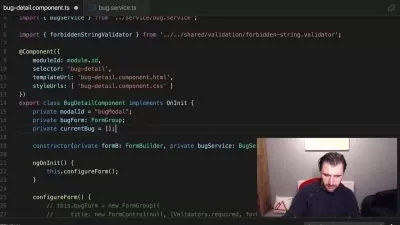Angular Signals In Depth (Angular 18)
Angular University
6:22:19
Description
Learn how to build modern Angular 18 applications with the new Signals API. Learn common signal-based UI patterns.
What You'll Learn?
- Code in Github repository with downloadable ZIP files
- Learn how to build modern Angular applications with Signals
- Learn Angular Signals in depth, including computed(), effect() and more
- Learn RxJs Interoperability with Signals
- Learn how to build an Angular application with minimal RxJs today
- Learn common UI signal-based patterns
- Learn error handling with Signals and signal-based Authentication
- Learn the master-detail pattern with Signals, and other commonly used patterns
Who is this for?
What You Need to Know?
More details
DescriptionThis Course In a Nutshell
I'm sure that you already heard a lot about Angular Signals, and how they provide you with a completely new way of writing Angular applications!
You probably also heard that RxJs is gradually becoming optional in Angular.
So the big question in everyone's mind is: what does an Angular application look like if it's written with signals and minimal RxJs?
And that is exactly what this course is all about!
We are going to build a small application in Angular using signals, and present you with some common design patterns that are you likely going to need almost for sure to build an application in signal style.
Course Overview
So here is how we are going to structure this course: we are going to start by explaining in detail what are signals in Angular, why they are useful, and cover in depth the 3 core primitives: signals, computed signals and effects.
Then we are going to use the core signal concepts to build a small Angular application from scratch using the new signal-based component authoring API (we will avoid the old API that is based on decorators).
We are going to cover a complete CRUD example using signals and a local backend, and we are going to cover different ways of doing HTTP in Angular using async/await, with and without the Angular HTTP client.
We are going to show how to do error handling, and cover how to implement using a signal-based approach common application features such as loading indicators, user messages handling, master-detail scenario, stateful signal-based services, and several other common application features and patterns that you are likely going to need.
We will also show how to handle authentication on the frontend using signals and functional guards.
And if you need RxJs for certain edge cases, you will also learn about the powerful RxJs interoperability that we have available with signals.
Table of Contents
This course covers the following topics:
Deep dive into Angular Signals
About signal-based change detection
Computed Signals
Effects
The new signal-based component API: inputs and outputs
Complete CRUD example with signals
HTTP with optional RxJs (two ways of doing it)
Error handling and signals
Loading indicators with signals
Stateful signal-based services
Handling user error messages with signals
Angular Authentication with signals
Signal-based view queries
viewChild, viewChildren, contentChild, contentChildren
Bi-directional binding with signals and the model() API
Master-detail scenario with Signals
RxJs Interoperability
Conclusion and final Thoughts
What Will You Learn In this Course?
In this course you are going to learn in detail how to use signals to build modern Angular applications using the new signal-based component authoring API, async/await and with minimal RxJs.
You are going to become familiar with a series of commonly used signal-based application patterns that you are going to need for sure in just about any signal based application that you will ever build.
At the end of the course, you will feel very comfortable with the core notions of signals, and you will know how exactly to use signals to build an Angular application from A to Z.
Have a look at the course free lessons, and please enjoy the course!
Who this course is for:
- Developers looking to learn how to build Angular applications using Signals
This Course In a Nutshell
I'm sure that you already heard a lot about Angular Signals, and how they provide you with a completely new way of writing Angular applications!
You probably also heard that RxJs is gradually becoming optional in Angular.
So the big question in everyone's mind is: what does an Angular application look like if it's written with signals and minimal RxJs?
And that is exactly what this course is all about!
We are going to build a small application in Angular using signals, and present you with some common design patterns that are you likely going to need almost for sure to build an application in signal style.
Course Overview
So here is how we are going to structure this course: we are going to start by explaining in detail what are signals in Angular, why they are useful, and cover in depth the 3 core primitives: signals, computed signals and effects.
Then we are going to use the core signal concepts to build a small Angular application from scratch using the new signal-based component authoring API (we will avoid the old API that is based on decorators).
We are going to cover a complete CRUD example using signals and a local backend, and we are going to cover different ways of doing HTTP in Angular using async/await, with and without the Angular HTTP client.
We are going to show how to do error handling, and cover how to implement using a signal-based approach common application features such as loading indicators, user messages handling, master-detail scenario, stateful signal-based services, and several other common application features and patterns that you are likely going to need.
We will also show how to handle authentication on the frontend using signals and functional guards.
And if you need RxJs for certain edge cases, you will also learn about the powerful RxJs interoperability that we have available with signals.
Table of Contents
This course covers the following topics:
Deep dive into Angular Signals
About signal-based change detection
Computed Signals
Effects
The new signal-based component API: inputs and outputs
Complete CRUD example with signals
HTTP with optional RxJs (two ways of doing it)
Error handling and signals
Loading indicators with signals
Stateful signal-based services
Handling user error messages with signals
Angular Authentication with signals
Signal-based view queries
viewChild, viewChildren, contentChild, contentChildren
Bi-directional binding with signals and the model() API
Master-detail scenario with Signals
RxJs Interoperability
Conclusion and final Thoughts
What Will You Learn In this Course?
In this course you are going to learn in detail how to use signals to build modern Angular applications using the new signal-based component authoring API, async/await and with minimal RxJs.
You are going to become familiar with a series of commonly used signal-based application patterns that you are going to need for sure in just about any signal based application that you will ever build.
At the end of the course, you will feel very comfortable with the core notions of signals, and you will know how exactly to use signals to build an Angular application from A to Z.
Have a look at the course free lessons, and please enjoy the course!
Who this course is for:
- Developers looking to learn how to build Angular applications using Signals
User Reviews
Rating
Angular University
Instructor's Courses
Udemy
View courses Udemy- language english
- Training sessions 66
- duration 6:22:19
- Release Date 2024/09/18










